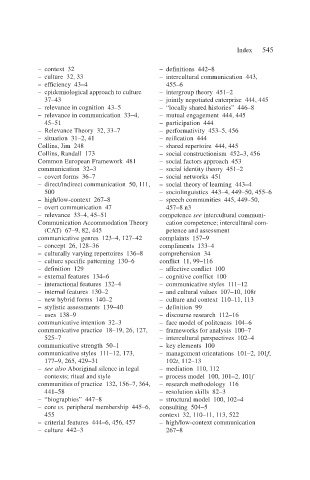Page 567 - Handbooks of Applied Linguistics Communication Competence Language and Communication Problems Practical Solutions
P. 567
Index 545
– context 32 – definitions 442–8
– culture 32, 33 – intercultural communication 443,
– efficiency 43–4 455–6
– epidemiological approach to culture – intergroup theory 451–2
37–43 – jointly negotiated enterprise 444, 445
– relevance in cognition 43–5 – “locally shared histories” 446–8
– relevance in communication 33–4, – mutual engagement 444, 445
45–51 – participation 444
– Relevance Theory 32, 33–7 – performativity 453–5, 456
– situation 31–2, 41 – reification 444
Collins, Jim 248 – shared repertoire 444, 445
Collins, Randall 173 – social constructionism 452–3, 456
Common European Framework 481 – social factors approach 453
communication 32–3 – social identity theory 451–2
– covert forms 36–7 – social networks 451
– direct/indirect communication 50, 111, – social theory of learning 443–4
500 – sociolinguistics 443–4, 449–50, 455–6
– high/low-context 267–8 – speech communities 445, 449–50,
– overt communication 47 457–8 n3
– relevance 33–4, 45–51 competence see intercultural communi-
Communication Accommodation Theory cation competence; intercultural com-
(CAT) 67–9, 82, 445 petence and assessment
communicative genres 123–4, 127–42 complaints 157–9
– concept 26, 128–36 compliments 133–4
– culturally varying repertoires 136–8 comprehension 34
– culture specific patterning 130–6 conflict 11, 99–116
– definition 129 – affective conflict 100
– external features 134–6 – cognitive conflict 100
– interactional features 132–4 – communicative styles 111–12
– internal features 130–2 – and cultural values 107–10, 108t
– new hybrid forms 140–2 – culture and context 110–11, 113
– stylistic assessments 139–40 – definition 99
– uses 138–9 – discourse research 112–16
communicative intention 32–3 – face model of politeness 104–6
communicative practice 18–19, 26, 127, – frameworks for analysis 100–7
525–7 – intercultural perspectives 102–4
communicative strength 50–1 – key elements 100
communicative styles 111–12, 173, – management orientations 101–2, 101f,
177–9, 265, 429–31 102t, 112–13
– see also Aboriginal silence in legal – mediation 110, 112
contexts; ritual and style – process model 100, 101–2, 101f
communities of practice 132, 156–7, 364, – research methodology 116
441–58 – resolution skills 82–3
– “biographies” 447–8 – structural model 100, 102–4
– core vs. peripheral membership 445–6, consulting 504–5
455 context 32, 110–11, 113, 522
– criterial features 444–6, 456, 457 – high/low-context communication
– culture 442–3 267–8

